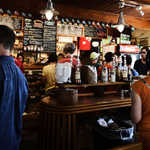As we approached the bend in the lane on our way back to our holiday caravan from Cart Gap, near Happisburgh, North Norfolk, we all caught sight of the field of blue to our left. “Wow! What is that??” I asked as we pulled up to take a closer look.
My daughter and I got out to take some pictures, although I find that photographs can never reproduce the full visual impact that hits you when you see an expanse of glorious colour like this in person. I realised it was a field of Borage, the flowers of which start off pink when freshly opened but become blue as they mature.
Now, I’m used to seeing this plant as a weed along our garden fence at home during the summer, but I’d never seen it grown as a crop like this. I remember my landlady 30 years ago telling me that when she was ‘in service’ in the 1940s she used to use Borage flowers (and leaves) to decorate Pimms Cup cocktails, before cucumber skin/slices came more into vogue as the preferred garnish, but I had no idea why a farmer would be cultivating this as a crop.
So I did some research (as best as I could using my phone and the rather patchy internet connection in that part of Norfolk!) and discovered that Borage seed oil is the richest-known natural source of GLA (gamma-linolenic acid) there is, and that the oil is usually sold under the name Starflower Oil. The picture below explains where that alternative name comes from.

So now I know why a farmer was growing a large field of Borage and I shall look out for more of this in the future. If anyone reading this has seen it being cultivated as a commercial crop then do let me know.
Incidentally, Cart Gap is 19 miles from Norwich, so why the auto-location feature at the top thinks this was taken in Norwich I have no idea!




